But wouldn't you know, the morning we were to leave the sun finally came out and purple-throated fruitcrows and Guianian red-cotingas came out to forage right around camp, but so high in the trees that I hadn't a prayer of a photograph. I was just stunned. Meanwhile, these crested currassows were spooking around the grounds, hoping the staff would put some more boiled rice out for their breakfast.
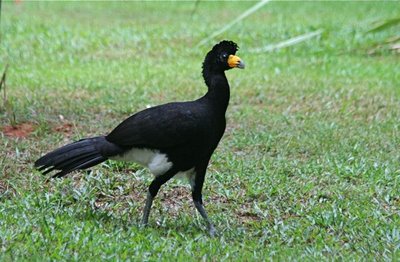
I think that's Boss Currassow in the middle. They have the Little Richard marcel 'do.
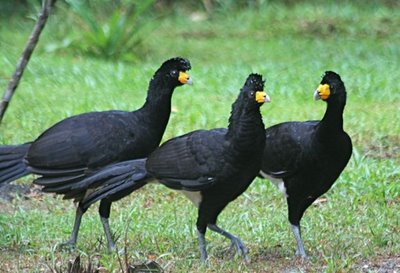
Currassows are cracids, like chachalacas and guans. They are the loveliest birds, but are unfortunately delicious, and cracids as a rule are really hard to find because wherever they occur throughout Latin America they get shot and eaten. Only in protected spots like national parks or archaeological sites do cracids become comfortable around people, so you have to seek out those places. I spent six months in Amazonian Brazil when I was in college, but didn't see my first currassow (a lovely pair of Greats) until Tikal, Guatemala, only three years ago. So these crested currassows were a tremendous treat to watch as they minced around camp.
It was time to hit the road again, so we bid farewell to the cotingas and cracids and climbed into trucks for transport to our next destination, Iwokrama Lodge. We'd take the road for awhile and then take boats on the Issequibo River. I opted to ride in the back of a pickup, standing up, because I wanted to see more birds. I saw a lot of birds, but also got pretty badly dehydrated in the heat and wind, as we traveled for many hours under the hot sun.
There were the loveliest trees growing all along the road, with great candelabras of gorgeous red flowers.
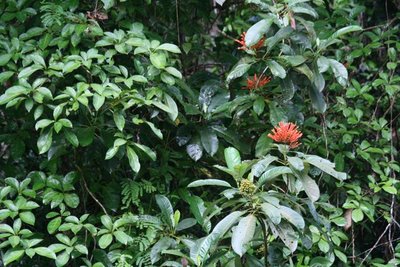
There were little trees, each bearing a natural hanging basket of bromeliads, sedums, philodendrons, orchids, cereuses, and who knows what all else. Nature is the best floral designer.
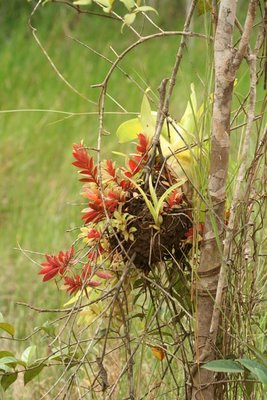
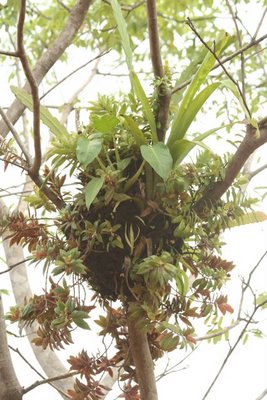 There was an enormous yellow-footed tortoise, like a boxy on steroids.
There was an enormous yellow-footed tortoise, like a boxy on steroids. 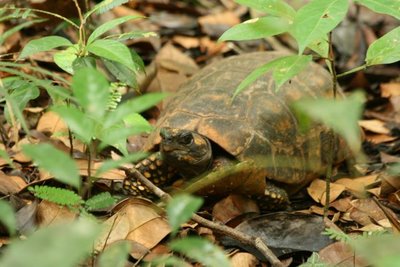
He was the size of a small watermelon, very Galapagoan.
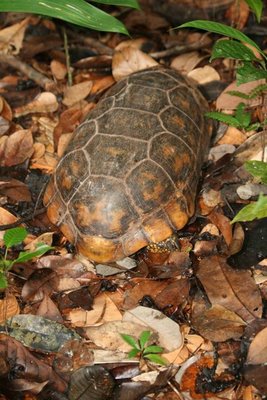
There was the tiny--I mean teeny tiny, eensy-weensy slinglike nest of a white-chinned sapphire hummingbird, or at least that was guide Ron Allicock's guess as to who might have built it. Charmed, I'm sure.
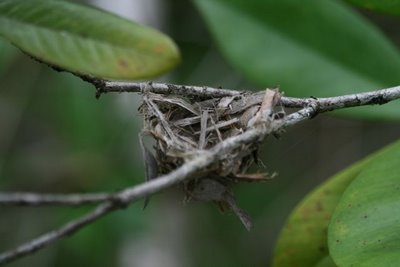
High overhead, a black and white hawk eagle soared and circled. Ahhhh. You beautiful, beautiful thing.
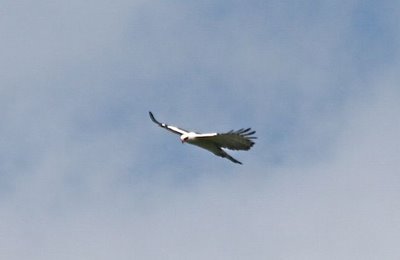
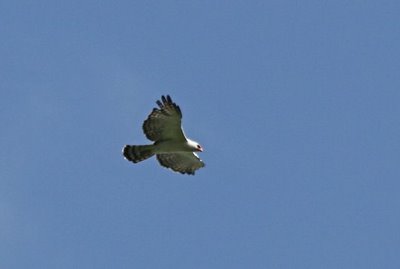 and, finally,
and, finally, 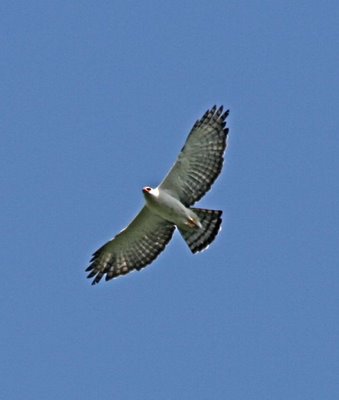
It was a cracking big stunner of a bird, clean and crisp in its markings, out there circling under the baking sun, looking down on us in our birding truck.
And then there were the butterflies. Big sulfurs, moving in tremendous flocks along the road for as long as we drove, and we drove all day. Try as I did, I couldn't make sense of their movements; they didn't seem to be migrating in any one direction the way monarchs do. They just seemed to be chasing each other back and forth. Here's a flock, puddling in a yard.
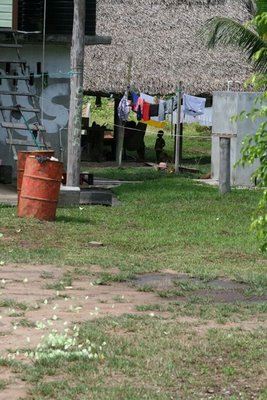
Mostly, they are greenish, with some bright yellow and a very few bright orange.
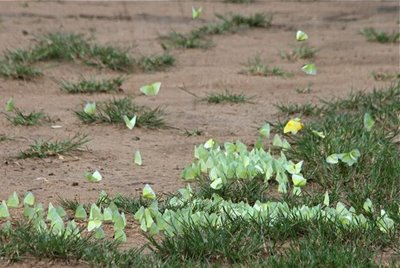
When you are in the back of an open truck, standing facing into the wind, it is like being in a blizzard, with each snowflake a large butterfly. Yes, they hit you in the face, very hard, and it hurts like crazy.
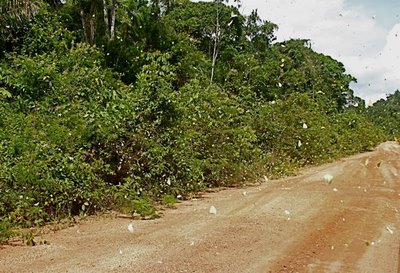
But it was worth it to be in a butterfly snowstorm.
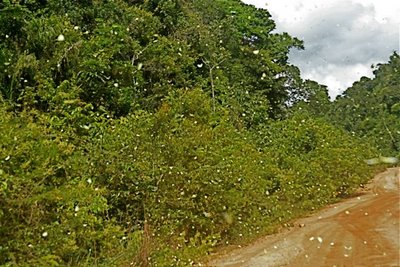
This was more butterflies than I have seen in my life until now, more butterflies than I expect to see for the rest of my entire life. I cannot convey what it was like to be in a blizzard of butterflies, virtually all day, unable to escape being hit by them, just as you cannot dodge the snowflakes.
At the end of the day we packed some beers, each conveniently labeled with a different fancy looking bikini 'ho,
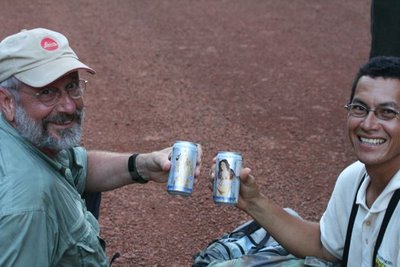
something Terry Moore and Ron Allicock seemed to appreciate more than Judy, Judy, Erica and I did.
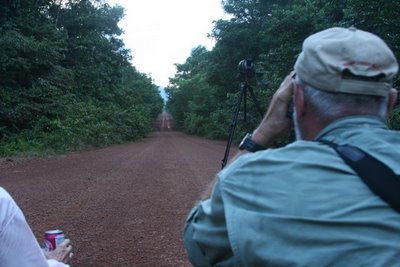
We watched until dark for a jaguar to cross the road, but none did. That's how jaguars usually roll. This is the only road between Guyana and Brazil's northeast, and we sat on it for a couple of hours and never had to get up for a truck. May it ever be thus, though I know it won't.






10 comments:
A soaring hawk eagle and a butterfly blizzard...what more could you want...maybe a jaquar crossing! I enjoy your stories!
What fun to be so well traveled. This was an exciting trip. The hawk eagle is incredible, and the butterfly brigade fascinating. I just can't imagine! Glad you had pictures to share.
More, more Guayana, please! Note to Macintosh for our wish-list: an armor-bodied, waterproof Mac.
Those are some funky looking birds.One of these days I'd like to travel out of new England and see some new birds.Until then, I'll read about other birder's adventures in blogs like yours.
blizzard of butterflies...
standing dehydrated on the back of a truck...
and everything else here
leaves me speechless.
Mary
Love your currasows and sulpher blizzards. The sulphers were doing the same thing on my little stretch of riverway west of you about the same week. The jungle guides that have lived there for years now - said they have never seen anything like it this year. They were in a migratory pattern going nowhere, it seemed. You take pics with your mouth closed for certain. It was blowing butterflies like fall leaves. Its way cool to see that we had the same experience in the same week in two separate parts of the continent.
Holy moly, what a post!
Fantastic hawk eagle, looks a great birding experience. I had to pop in and thank you for the interesting article in the March/April edition of Bird Watcher's Digest on window strikes. I recently lost a Coopers hawk from a window strike http://owlbox.blogspot.com/search/label/Window%20strike and I am currently looking into some solutions and your article was very helpful.
The hawk eagle is magnificent! Beautiful! Then again, I have a thing for predators, so I'm always gaga for birds of prey.
Your experience with the butterflies is interesting. I live in the Texas funnel that brings monarchs together in vast numbers as they migrate south, so I've come to expect seeing them in great clouds of fluttering wings and resting in such numbers as to cover whole cypress trees--top to bottom. Yet it surprises me to see sulfurs doing that. Mating? Strength in numbers? In any case, it looks like a fantastic experience and a memorable sight.
Speechless...wishing for butterfly blizzards.
Post a Comment